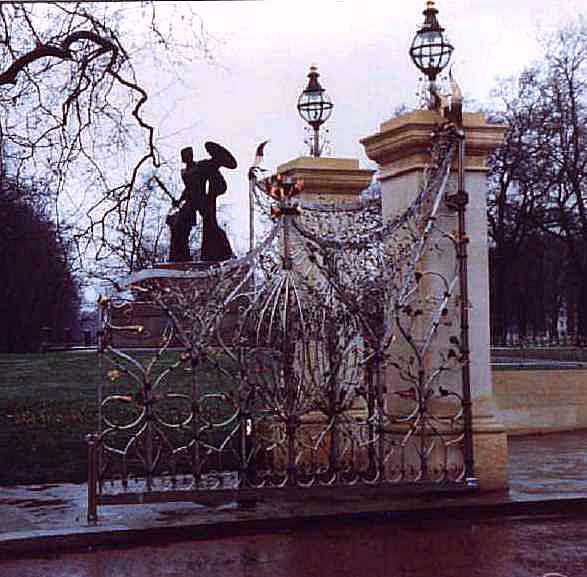Queen Mother's Gate on:
[Wikipedia]
[Google]
[Amazon]

 Queen Elizabeth Gate, also known as the Queen Mother's Gate, is an entrance consisting of two pairs and two single gates of forged stainless steel and bronze situated in
Queen Elizabeth Gate, also known as the Queen Mother's Gate, is an entrance consisting of two pairs and two single gates of forged stainless steel and bronze situated in

 Queen Elizabeth Gate, also known as the Queen Mother's Gate, is an entrance consisting of two pairs and two single gates of forged stainless steel and bronze situated in
Queen Elizabeth Gate, also known as the Queen Mother's Gate, is an entrance consisting of two pairs and two single gates of forged stainless steel and bronze situated in Hyde Park, London
Hyde Park is a , historic Listed building#Heritage protection, Grade I-listed urban park in Westminster, Greater London. A Royal Parks of London, Royal Park, it is the largest of the parks and green spaces that form a chain from Kensington P ...
, behind Apsley House
Apsley House is the London townhouse of the Dukes of Wellington. It stands alone at Hyde Park Corner, on the south-east corner of Hyde Park, facing towards the large traffic roundabout in the centre of which stands the Wellington Arch. It ...
at Hyde Park Corner
Hyde Park Corner is between Knightsbridge, Belgravia and Mayfair in London, England. It primarily refers to a major road junction at the southeastern corner of Hyde Park, that was originally planned by architect Decimus Burton. The juncti ...
. There is also a centre feature made of painted cast iron.
It was opened by Queen Elizabeth II
Elizabeth II (Elizabeth Alexandra Mary; 21 April 19268 September 2022) was Queen of the United Kingdom and other Commonwealth realms from 6 February 1952 until Death and state funeral of Elizabeth II, her death in 2022. ...
in 1993 to celebrate the 90th birthday of her mother, Queen Elizabeth The Queen Mother
Elizabeth Angela Marguerite Bowes-Lyon (4 August 1900 – 30 March 2002) was Queen of the United Kingdom and the Dominions of the British Commonwealth from 11 December 1936 to 6 February 1952 as the wife of King George VI. She was al ...
. It cost £1.5 million to construct, raised by private individuals and public funding, under the patronage of Prince Michael of Kent
Prince Michael of Kent (Michael George Charles Franklin; born 4 July 1942) is a member of the British royal family who is 53rd in line to the British throne as of 2025. The younger son of Prince George, Duke of Kent, and Princess Marina of Gr ...
.
The stainless steel and bronze gates, railings and lights were designed and made by Giusseppe Lund. The centre piece, featuring a red lion (England) and a white unicorn
The unicorn is a legendary creature that has been described since Classical antiquity, antiquity as a beast with a single large, pointed, spiraling horn (anatomy), horn projecting from its forehead.
In European literature and art, the unico ...
(Scotland), was designed by sculptor David Wynne.
The organic nature of the forged steel reflects the Queen Mother's love of flowers, particularly those from a cottage garden. Her life spanned most of the century and this is represented by a flow from formal symmetry at the base of the gates upwards to an increasing freedom of line at the top. Many of the elements are free to move when touched and the whole structure vibrates when moved. This is in direct contrast to the heavier rectilinear gates found in other entrances to the park.
Although much admired, it was described as "hideous" by architect Zaha Hadid
Dame Zaha Mohammad Hadid ( ''Zahā Ḥadīd''; 31 October 1950 – 31 March 2016) was an Iraqi-born British architect, artist, and designer. She is recognised as a key figure in the architecture of the late-20th and early-21st centuries. Born ...
. Another architect, Richard Rogers
Richard George Rogers, Baron Rogers of Riverside (23 July 1933 – 18 December 2021) was a British-Italian architect noted for his modernist and constructivist designs in high-tech architecture. He was the founder at Rogers Stirk Harbour + ...
, described it as "romantic candyfloss", and Viscount Linley, a grandson of the Queen Mother's, was reported as saying that he "absolutely loathed" the work. The then arts minister, Lord St John of Fawsley
Norman Antony Francis St John-Stevas, Baron St John of Fawsley, ( ; born Norman Panayea St John Stevas; 18 May 1929 – 2 March 2012) was a British Conservative politician, author and barrister. He served as Leader of the House of Commons in th ...
, said they were "full of joy, strength and courage, like the personage in whose honour they have been created".
There were also initial concerns that the metal was rusting due to a misunderstanding of the nature of the gate's colouring which was in fact a deliberate creation of chromium oxides with the application of heat. This treatment has since proved to be extremely durable thanks to the initial intensifying of the chromium content on the surface by the use of electro-polishing
References
Gates in England Buildings and structures in Hyde Park, London Buildings and structures completed in 1993 Sculptures of lions in the United Kingdom Sculptures of unicorns Animal sculptures in London {{London-stub